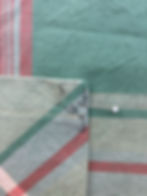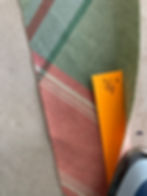Stitch a Chef Apron
- Londa
- Aug 20, 2020
- 6 min read
Updated: Feb 18
These directions are my ‘new and improved’ techniques to stitch a chef apron. This will create a well-sewn classic Chef Apron. I have used the pattern pieces from the McCalls 5358 (2007). Honestly, it amazes me how very minimal the included directions are for a simple project like this chef apron - a great gift for anyone! Especially, since this project looks line one perfect for a new sewer, I found the poor directions to be disappointing. Below, I have written new and complete directions in order to prepare for teaching this as a project for my Young Sewers (age 9 and up) class. Skills taught in these directions include learning how to: create a continuous binding, apply bias binding that looks good on the front AND the back, create smooth edges and how to secure corners on a patch pocket that will get hard use.


Stitch a Chef Apron: Sewing Supplies
Fabric: I strongly recommend a heavier home-dec type fabric with ample body for this project (though not as heavy as a jeans-type denim.) All cotton will make the bias shaping respond easily to shaping. Prints will camouflage stitching more than solids.
54” or 60” fabric: 1 3/8 yard
45” fabric: 1 1/2 yard PRESHRINK THE FABRIC!!!
Lighter Weight Fabrics: Add fusible woven interfacing for the Front Upper edge and to ‘beef up’ the entire Pocket, or at least the upper edge of the Pocket. 1/4 yard would be enough.
Thread: the thread will show everywhere - so take care when selecting the color.
Cardboard - to cut a template for the pocket and a 3/4” template for tie pressing.
Cutting
Pattern pieces define the cutting. You are cutting one Pocket, one Binding on the bias, and one Front - on the fold.
Stitching Directions
Finish Front Upper Edge
If using a lighter weight fabric, fuse fusible interfacing to the upper edge - it should be 1 1/4” wide.
1. Press 1/4” to the wrong side at the top edge. Stitch with a wide zigzag stitch.
2. Stitch right along the folded edge from the wrong side to secure it in place.
You can buy supplies like the interfacing from my Notions Shop:
Prepare & Attach Patch Pocket
To see the magic of a cardboard pocket template, watch the beginning of the video on my YouTube Channel: Patch Pocket Magic. You can watch the video below from my Youtube Channel:
1. Cut a cardboard template to the FINISHED SIZE of the Pocket - so that means withOUT the upper facing part and withOUT the side and lower 5/8” seam allowances. I do this by first carefully marking the 5/8” seam allowance on the sides and lower edges of the pattern piece. Lay the pattern piece on top of a piece of cardboard (like the back of a desk calendar) and ‘draw’ along the seam LINE with a tracing wheel or even a kitchen table knife.
Interface upper edge/entire pocket with fusible interfacing if using a lighter weight fabric.
2. Press under 1/4” at the upper edge to the wrong side. Zig zag.

3. Using Cardboard Template as created in Step 1, press the edges and the upper edge around the template taking care to ease in the fullness at the rounded corners using a lot of STEAM.
4. Turn the upper edge to the RIGHT side and stitch right along the pressed straight side edges as shown below. Trim the seam allowance at an angle as shown in the photo.

5. Turn the upper edge to the inside and press, achieving nice square upper side corners.
6. Locate prepared Patch Pocket on the front by pressing the pocket in half top to bottom, and the Front in half so that you can exactly match the centers.

7. Sketch in the reinforced upper corner stitching as shown below. Note the arrows indicating directional stitching. You’ll be starting at the stitching line, angling up to the inner top corner, across the upper edge, and then down the side and around to the other upper corner where you stitch in the reverse direction, ending at the same upper stitching line.
It should look like this:

Hem Lower and Side Edges
1. Press lower and side straight edges 5/8” to the wrong side.

Do the lower HEMLINE edge first…
2. Turn raw edge in to match the pressed edge, turn again and topstitch - stitching close to the innermost stitched edge from the wrong side.
In the same manner, stitch the straight side edges - as shown in the picture to the right.
This is what I call my 'Narrow Hem' and I also have a video on how I do it. Find it at this link, and posted at the end of this post.
You can watch the video from my channel below:

Prepare Binding
1. Using the LONG, bias pattern piece which is 9" long and about 49" long. With great precision, draw lines the length of the bias at 3”. You should have 2 lines, dividing this 9” wide bias piece into three 3” strips.
2. Stick a pin from the wrong side to the right side right at the seam LINE of the short end on the middle line. Poke it into the exact same spot on the other short end to exactly 'key' or match these lines right AT the seam Line. At each of the ends, you’ll have 3” ‘hanging’ as shown below.

3. Again, the drawn lines should also meet exactly AT THE SEAM LINE. This seam is straight grain and you’ll need to really stretch it firmly, taut, as you stitch to keep the matched points matched. Again, at each of the ends, you’ll have 3” ‘hanging’ as shown below.

4. Using a large scissors, cut exactly along the drawn lines and you’ll have one continuous LONG bias strip, all stitched together. Press seam allowance open and trim the diagonal corners off at the seams.
Attach Binding

1. Cut binding in half crosswise into 2 pieces.
2. Pin the RIGHT side of the Bias to the WRONG side of the curved Front edges as follows:
*Allow 19” for the tie length at the neck, so above the upper Front edge.
*Measure 13.5” along the Binding and pin that to the curved side edge with the pins on the Front side. This measurement is purposely less than the corresponding length of the curved Front edge, because you must ease the curved edge INTO the Binding.
*That leaves roughly 25.5” for the waist tie length.

3. Stitch, with the Front edge on TOP at the machine, so that you can be sure you don’t stitch in any folds. This seam allowance is 3/4” wide.
Be sure to exactly align the curved edge of the Front to the straight edge of the Binding. As you do this, you'll find that the Front buckles up a bit as it is a curved line. You can see this tendency in the photo at the right.

4. Press the Binding outwards, away from the apron from the wrong side of the Front.
5. Flip it all over, right side up. Press and shape the Binding around the cut edge of the curved sides - tightly, yet not ‘bending’ any of the seam allowance.

6. Carefully press the remaining Binding raw edge under so that it will exactly cover the stitching line when you topstitch it in the next step. Doing this will shape the bias in a nice curve. I found that turning under approximately 3/8" accomplished this.
Pinning parallel right along the edge with the head of the pin downwards will allow you to hold the edge in place as you stitch, removing the pin as you get to it. But don't stitch yet - as you still need to prepare the remaining loose 'tie edges'.

7. For the last step, press and stitch the loose ends of the ties. To do this, use a 3/4” wide cardboard template to press that long edge inward.

At the ends, trim the angled ends straight, and press in.

8. To create a width equal to that of the curved portion of the Front, I found that pressing under about 3/8” on the remaining long edge worked. Press the center long edge, and pin to prepare for stitching close to the matched loose edges. Carefully stitch - the entire length of the bias, backstitching to secure and trim threads closely.
The photo below shows how this should look at the upper edge of the apron.

Here's a closeup - note 'she' is in front of my Studio refrigerator!

Depending on the fabric selected, this makes a great GIFT.
Sizing? To enlarge, cut down the center of the Front and add whatever additional width is needed.
Directions copyright 2020 by Londa J. Rohlfing Londa’s Creative Sewing





